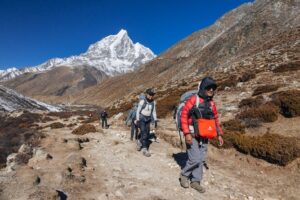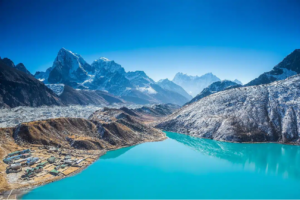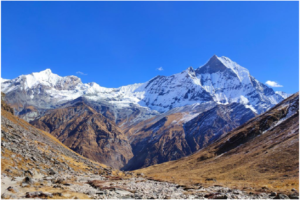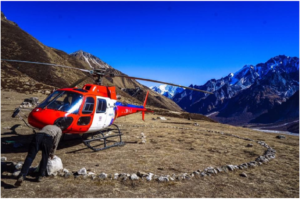Where the Mountains Call: Trekking ABC, Langtang, Manaslu & Everest:
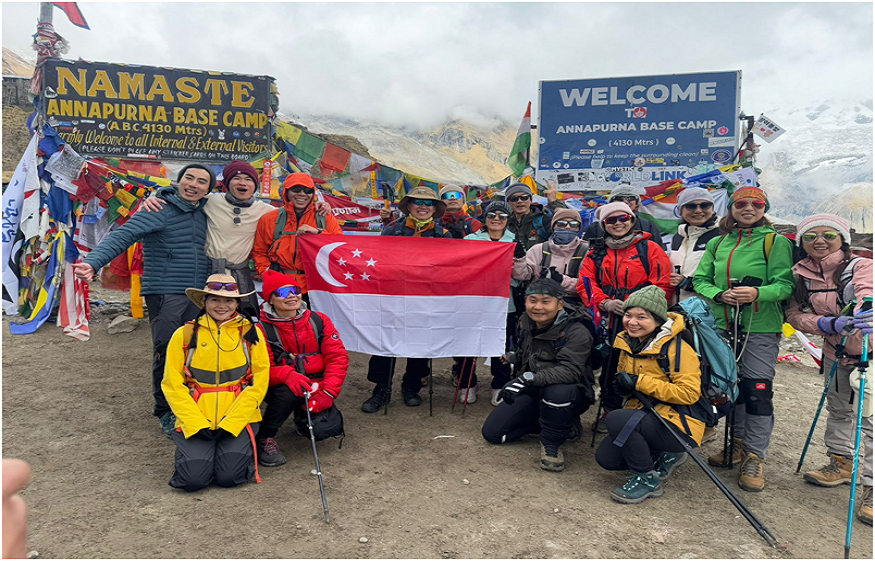
Nepal is more than a goal — it is a call to the soul. An arrival of compelling peaks, sacrosanct streams, and ageless societies, Nepal welcomes travelers to take off behind the clamor of the world and take after old trails that lead to a few of Earth’s most awe-inspiring places. From the emerald woodlands of the Annapurna region to the solidified statues of the Everest Three Passes, Nepal’s trails are living ways of discovery.
Four treks, each a magnum opus in its claim right, stand out for their magnificence, differences, and challenge: the Annapurna Base Camp trek, Langtang Valley trek, Manaslu Circuit trek, and Everest Three Pass trek. These courses are not a fair almost prevailing rise; they are around finding association — to nature, culture, and something profound within.
Annapurna Base Camp Trek
The Annapurna Base Camp trek is one of the most well known and cherished trekking encounters in Nepal — and for great reason. It combines characteristic splendor, social abundance, and direct challenge into a single exceptional travel. The trek leads into the heart of the Annapurna Haven, a cold bowl ringed by towering Himalayan giants.
The path starts in the foothills of Pokhara, regularly from Nayapul or Ghandruk, and winds through terraced farmland, thick rhododendron woodlands, bamboo forests, and enthusiastic Gurung towns like Chhomrong and Sinuwa. Each town offers warm neighborliness, where trekkers are invited with home-cooked suppers and stories by the fire.
Standing at the Base of the Giant
The last extend to Annapurna Base Camp (4,130 meters) is nothing short of radiant. Encompassed by peaks such as Annapurna I (8,091 m), Machapuchare (Fishtail), Hiunchuli, and Gangapurna, trekkers discover themselves in a characteristic amphitheater of snow and sky. At dawn, the mountains turn to gold, and each hardship of the path breaks down in wonder.
The ABC trek regularly takes 7–12 days and is perfect for both first-time trekkers and experienced explorers. It’s open, however profoundly fulfilling — an idealized mix of physical experience and tranquil submersion in nature.
Langtang Valley Trek
A Sacrosanct Path Near to Kathmandu
Often ignored in favor of its more celebrated neighbors, the Langtang Valley trek is one of Nepal’s covered up treasures. Found fair north of Kathmandu, this trek offers a quiet elude into snow capped wilderness, improved by Tamang and Tibetan Buddhist culture. It is a perfect course for those looking for isolation, excellence, and important connection.
The trek starts from Syabrubesi, driving through profound woodlands lively with ruddy pandas, Himalayan dark bears, and langurs. The Langtang Khola Waterway guides you upward past moss-covered rocks, cascading waterfalls, and wooden lodges tucked underneath towering cliffs.
A Valley Renewed from Tragedy
After passing through Llama Inn and Ghodatabela, trekkers reach Langtang Town, which was deplorably crushed by the 2015 seismic tremor. The unused town stands as a confirmation to human strength and the persevering soul of the neighborhood people.
From there, the path proceeds to Kyanjin Gompa (3,870 m), a quiet settlement encompassed by cold peaks. This town is domestic to an old cloister and a yak cheese production line, both of which offer calm bits of knowledge into mountain life.
Adventurous trekkers can climb Tserko Ri (4,984 m) or Kyanjin Ri, both of which offer marvelous views of Langtang Lirung, Dorje Lakpa, and the endless frosty scope of the region.
Typically enduring 7 to 10 days, the Langtang Valley trek is brief but wealthy. It is a trek of otherworldly stillness and characteristic beauty, where the mountains whisper or maybe then shout.
Manaslu Circuit Trek
Around the Eighth-Highest Top on Earth
For those who pine for remoteness and rough magnificence, the Manaslu Circuit trek is a trek into the wild heart of the Himalayas. Circling Mount Manaslu (8,163 m) — the world’s eighth-highest mountain — this trek navigates a few of Nepal’s most emotional and untouched landscapes.
Beginning in Soti Khola, the path takes after the Budhi Gandaki Waterway, cutting through rich subtropical timberlands, soak gorges, and high-altitude levels. Suspension bridges extend over wild streams, and the territory slowly shifts from rice patios to rough tundra.
Culture on the Edge of the Sky
The Manaslu region is a social intersection where Gurung, Tibetan, and Nubri impacts meet. Towns like Namrung, Lho, Sama Gaun, and Samdo sit like islands of confidence and convention, with main dividers, chortens, and turning supplication wheels at each turn. Old cloisters such as Pungyen Gompa, tucked underneath the shadow of Manaslu, welcome trekkers to park and reflect.
The delegated minute of the trek is the crossing of Larkya La Pass (5,106 m) — a long, windswept trip over ice and shaking. The sees from the best span over Cheo Himal, Himlung, and indeed parts of the Annapurna extend. The plunge into Bimthang is a last discharge, floating down into elevated knolls and rhododendron forests.
The Manaslu Circuit ordinarily takes 14 to 18 days, and since it lies in a limited region, an uncommon permit and direct route are required. It is a genuine off-the-beaten-path trek — one that offers profound isolation, towering scenes, and experiences with societies molded by elevation and time.
Everest Three Pass Trek
The Extreme Himalayan Challenge
For trekkers looking for the most elevated, hardest, and most awe-inspiring course, the Everest Three Pass trek is the crown gem. It is not a fair path; it’s a full submersion into the Khumbu region, with its sacrosanct peaks, ice sheet intersections, and tall mountain passes that will test both body and spirit.
Starting from Lukla, the path climbs through classic parks like Phakding, Namche Bazaar, Tengboche, and Dingboche, some time recently veering from the standard Everest Base Camp route.
The Three Great Passes
The trek’s namesake challenges — Kongma La (5,535 m), Cho La (5,420 m), and Renjo La (5,360 m) — are among the most elevated and most picturesque trekking passes in Nepal. Each crossing uncovers an unused aspect of the Khumbu: frigid ice sheets, turquoise lakes, covered up valleys, and sharp ridgelines surrounded by Himalayan titans.
Along the way, trekkers visit Everest Base Camp (5,364 m), climb Kala Patthar (5,545 m) for dawn views of Everest, and investigate the flawless Gokyo Lakes — an arrangement of elevated gems settled among snow-capped peaks.
The last leg takes trekkers through Thame, a calm Sherpa town wealthy in history and otherworldly legacy, some time recently plummeting back to Lukla.
This epic travel takes 18 to 21 days, and due to its elevation and remoteness, it requests solid wellness, acclimatization, and continuance. For those who total it, the Everest Three Pass trek gets to be not just a memory, but a point of reference — one that characterizes the Himalayan dream.
Sacred Scenes and Living Culture
More Than Mountains
What makes trekking in Nepal exceptional is not the greatness of its peaks, but the individuals, supplications, and ways that characterize the travel. Each of these treks passes through towns formed by antiquated conventions, where Buddhist religious communities, chortens, mani stones, and supplication banners imbue the scene with otherworldly life.
Hospitality is a trademark of Himalayan trekking. In each teahouse, trekkers discover consolation in straightforward suppers, inviting faces, and shared stories. Whether tasting butter tea in a Manaslu town or sharing giggles with doormen in Namche, human association gets to be a central portion of the trail.
Preparing for the trek
When to Go
Spring (March–May): Perfect climate, blooming rhododendrons, and steady conditions.
Autumn (September–November): Clear skies, Great mountain perceivability, and merry atmosphere.
Permits Required
Annapurna & Langtang: TIMS Card and preservation zone permit
Manaslu: Confined Zone Allow + ACAP + MCAP + authorized guide
Everest: Sagarmatha National park Allow + Khumbu Pasang Lhamu Country District Permit
Essential Trekking Gear
- Layered clothing for all temperatures
- Waterproof boots and jacket
- Sleeping sack (evaluated to -10°C or lower)
- Trekking posts and headlamp
- Water filtration tablets or filter
- Sunscreen, shades, and a wide-brim hat
Hiring an authorized direct and doorman is profoundly prescribed for social experiences, security, and back. Not as it does this improves your travel, but it moreover bolsters the neighborhood economy.
Conclusion:
Trekking the Himalayas is not basically a wear — it is a custom of section, a trek into a few of the world’s most farther, lovely, and profoundly charged places. Whether you are standing in the heart of the Annapurna Asylum, strolling through Langtang’s quiet valleys, crossing the frosty edges of Manaslu, or rising over the clouds on the Everest Three Passes — Nepal clears out its check on your soul.Each trek is a way of change. You arrive as one individual and return as another — more grounded, calmer, fuller.
So when the mountains call, tune in. They are not fair summits to climb, but mirrors reflecting the best of what we can get to be. With the Annapurna Base Camp trek, Langtang Valley trek, Manaslu Circuit trek, and Everest Three Pass trek, you’ll discover more than trails — you’ll discover truth, ponder, and the travel of a lifetime.
Contact Details
Company address: Everest Trekking Routes Pvt. Ltd.
16 Khumbu, Nayabazaar, Kathmandu, Nepal
Mobile : +977-9843467921 (Rabin)
Email: [email protected]

